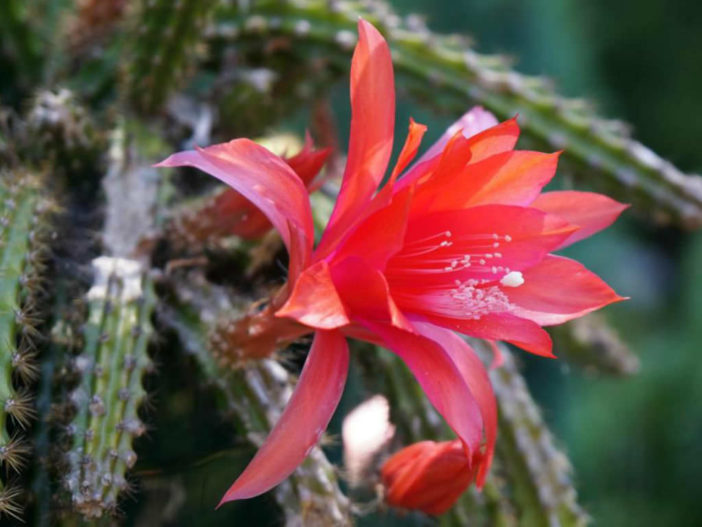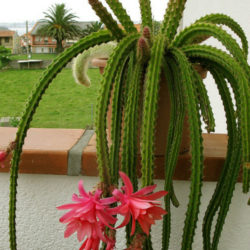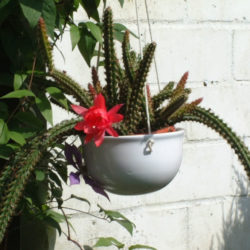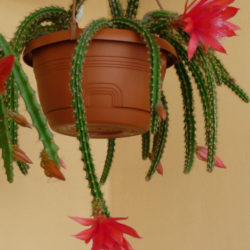Scientific Name
Disocactus × mallisonii (Otto & A.Dietr.) Barthlott
Common Name(s)
Rat's Tail Cactus
Synonym(s)
Aporocactus × mallisonii, Cactus × mallisonii, Cereus × mallisonii, Cereus ×smithii, ×Aporodisocactus mallisonii, ×Aporoheliocereus mallisonii, ×Aporoheliocereus smithianus var. mallisonii
Scientific Classification
Family: Cactaceae
Subfamily: Cactoideae
Tribe: Hylocereeae
Genus: Disocactus
Description
Disocactus × mallisonii, also known as ×Aporoheliocereus mallisonii, is a cactus with slender, green, pendent stems with 6 to 8 ribs lined with clusters of short, yellowish-brown spines. The stems can grow up to 3 feet (90 cm) long and 0.4 inches (1 cm) in diameter. They turn brownish when exposed to intense sunlight.
The flowers are bright pink or red, with white stamens, and appear in spring, open during the day, and can last for several days. They are funnel-shaped, up to 3 inches (7.5 cm) long and 2 inches (5 cm) in diameter. The fruits are oval, spiny berries.
Origin
This cactus is a hybrid that results from a cross between Disocactus flagelliformis and Disocactus specious. It was first described and published by Christoph Friedrich Otto and Albert Gottfried Dietrich as Cereus × mallisonii but was revised and reclassified by Wilhelm A. Barthlott in 1991.

Hardiness
USDA hardiness zones 10a to 11b: from 30 °F (−1.1 °C) to 50 °F (+10 °C).
How to Grow and Care
Many of the cultivated plants known as Epiphyllum hybrids are derived from crosses between species of Disocactus (rather than Epiphyllum) and other genera in the Hylocereeae.
Disocactus should be grown in rich but still well-draining soil. They should be watered regularly and fertilized as well. This is essential for good growth and flowering. During the growing period, the plants need frequent watering. The watering should be rather abundant so that the soil becomes completely soaked, but let dry between watering. Keep relatively dry in winter or when night temperatures remain below 50 °F (10 °C).
These cacti dislike extreme heat and cold, so they are best green-housed during the depth of winter and heat of summer in hot, dry climates. They also prefer shade to sun and like a little extra humidity.
Disocactus can be reproduced both by seeds and cuttings.
See more at How to Grow and Care for Disocactus.
Links
- Back to genus Disocactus
- Succupedia: Browse succulents by Scientific Name, Common Name, Genus, Family, USDA Hardiness Zone, Origin, or cacti by Genus
Photo Gallery
Click on a photo to see a larger version.


